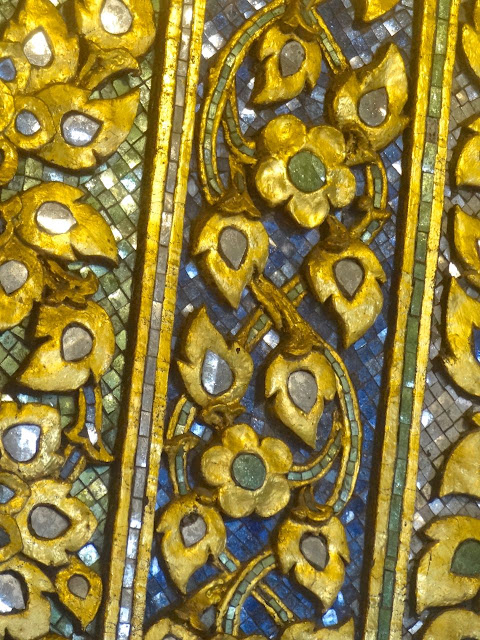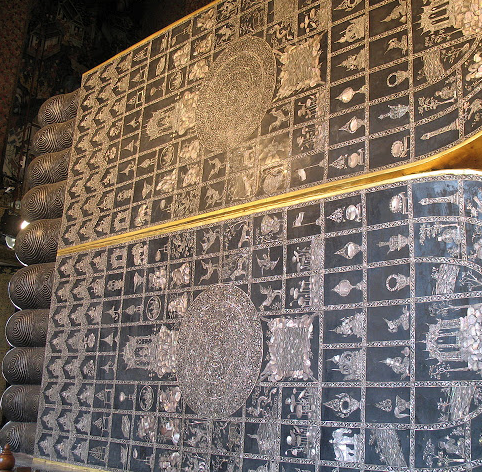Soaring columned exterior of the Temple of the Reclining Buddha
The Reclining Buddha, at 150-feet long is the largest Buddha statue in Thailand
Covered in gold leaf and decorated with mother-of-pearl inlay on his eyes and the soles of his feet, the Buddha rests on two box-pillows richly encrusted with glass mosaics
Closeup of the Reclining Buddha's tight curls and "pillow"
Richly coloured mosaic detail of the Temple of the Reclining Buddha interior wall
The soles of the Buddha's feet inlaid with mother-of-pearl display the 108 auspicious signs
which distinguish a true Buddha
Behind the Reclining Buddha are 108 bowls for those wishing to donate to the temple
Gold leaf detail on the doors of the temple with image from Thailand's popular national epic Ramekin — "Glory of Rama" — which is derived from the Hindu epic
Exterior carved and mirrored exterior detail
Missakawan Park is a small raised garden beside the Temple of the Reclining Buddha with a Chinese style pavilion with its famous Bodhi Tree
A Bodhi Tree is the centrepiece of the garden, which was propagated from the Jaya Sri Maha Bodhi tree in Sri Lanka that is believed to have originally came from a tree in India where Buddha sat while awaiting enlightenment
Reclining at Wat Pho, apart from the enormous Buddha, are a number of well fed cats
The Phra Ubosot is the Ordination Hall, the main hall used for performing Buddhist rituals, and the most sacred building of the Wat Pho complex. It was constructed by King Rama I in the Ayuthaya style, and later enlarged and reconstructed in the Rattanakosin style by Rama III. The bot was dedicated in 1791, before the rebuilding of Wat Pho was completed. Inside the ubosot is a gold and crystal three-tiered pedestal topped with a gilded Buddha topped with a nine-tiered umbrella representing the authority of Thailand. Rama IV later placed some ashes of Rama I under the pedestal of the Buddha image so that the public may pay homage to both Rama I and the Buddha at the same time.
Ornate gold leaf and coloured mosaic doorframe of Ordination Hall's Gold Buddha
The Buddha in the ordination hall is the "Phra Buddha Deva Patimakorn" in a seated posture on a three tiered pedestal under which are some ashes of King Rama I
Hand carved gold leaf and lavishly coloured pediment above each of the windows of the Ubosot
Detail of the exterior
A bronze mythological lion guards the Ubosot
Surrounding the Ubosot is the Phra Rabiang cloister with almost 400 Buddhas
One of a small group of Thai schoolchildren painting images of the Buddha
The ubosot is enclosed by a low wall called 'kamphaeng kaew' meaning 'jewelled walls',
which is punctuated by gateways guarded by mythological lions
Ornate entrance and pediment to Phra Rabiang Cloisters
Gorgeous pediment with coloured mirror and carved gold leaf detailing
These stone lion statues were originally imported as ballast on ships trading with China
Three of 71 small chedis called Phra Chedi Rai, built by Rama III
The small Phra Chedi Rai dotted around the cloisters
Small chedis in front of cloisters with gable of large Viharn
Buddha with protective Naga in one of four Viharns marking the 4 cardinal points,
each housing a unique Buddha
The 'Phra Mondop' or the Scripture Hall
Entrance to 'Phra Mondop' or the Scripture Hall which contains a small library of Buddhist scriptures inscribed on palm leaves, and are kept in a controlled environment for their preservation
Scripture Hall
Closeup of the ceramic detailing
Next to the Reclining Buddha Wiharn is an enclosure holding the four largest of the temple's 95 pagodas. All of these chedis at Wat Po are square, rather than the round bell shape generally preferred at the time, and are decorated with ceramic tiles and three dimensional ceramic pieces which form intricate floral patterns. The centre of the three chedi is the oldest, having been built by Rama I to hold the Phra Si Sanphet Buddha image bought from Ayutthaya; later, Rama III built the north chedi to hold the ashes of Rama II; and the south to hold his own remains; the fourth chedi was built by Rama IV for unknown purposes.
Two of the four main Royal Chedis which were dedicated to first four Chakra kings
Detail of the blue Royal Chedi
One of the four great Chedi decorated with colour-glazed tiles
and end in a tall spire decorated with colourful mosaics
View of the Wat Pho complex with small Phra Chedi Rai which contain ashes of the royal family and slightly larger Royal Chedi clustered in groups of five contain the relics of Buddha
The inner walls of the portico depict scenes from the Ramayana, flanked by sheltered gates guarded on both sides by Chinese-style giants
Other stone giants depict the English identified by the top hat!
Bearded with a big nose and top hat, the sculptors were poking fun at the "farang",
a generic Thai word for someone of European ancestry, no matter where they may come from
Small open-air pavilion adjacent to the Scripture Hall
The dazzling ceramic encrusted spire of the Phra Mondop, or Scripture Hall
View of the Scripture Hall complex












































No comments:
Post a Comment